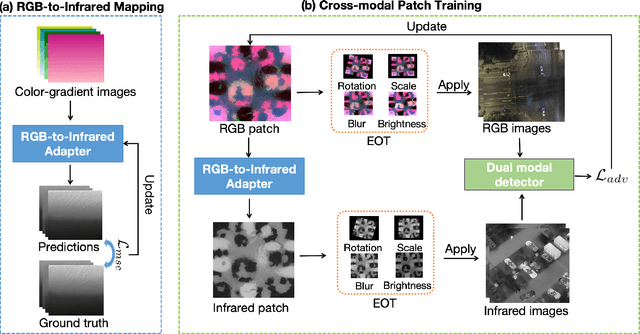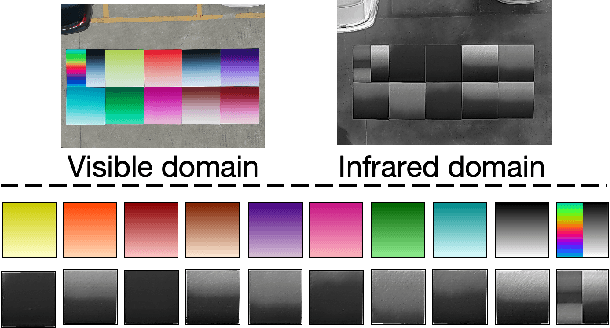Wen Yao
National Innovation Institute of Defense Technology, Chinese Academy of Military Science
SynergyWarpNet: Attention-Guided Cooperative Warping for Neural Portrait Animation
Dec 19, 2025Abstract:Recent advances in neural portrait animation have demonstrated remarked potential for applications in virtual avatars, telepresence, and digital content creation. However, traditional explicit warping approaches often struggle with accurate motion transfer or recovering missing regions, while recent attention-based warping methods, though effective, frequently suffer from high complexity and weak geometric grounding. To address these issues, we propose SynergyWarpNet, an attention-guided cooperative warping framework designed for high-fidelity talking head synthesis. Given a source portrait, a driving image, and a set of reference images, our model progressively refines the animation in three stages. First, an explicit warping module performs coarse spatial alignment between the source and driving image using 3D dense optical flow. Next, a reference-augmented correction module leverages cross-attention across 3D keypoints and texture features from multiple reference images to semantically complete occluded or distorted regions. Finally, a confidence-guided fusion module integrates the warped outputs with spatially-adaptive fusing, using a learned confidence map to balance structural alignment and visual consistency. Comprehensive evaluations on benchmark datasets demonstrate state-of-the-art performance.
RAVES-Calib: Robust, Accurate and Versatile Extrinsic Self Calibration Using Optimal Geometric Features
Dec 09, 2025Abstract:In this paper, we present a user-friendly LiDAR-camera calibration toolkit that is compatible with various LiDAR and camera sensors and requires only a single pair of laser points and a camera image in targetless environments. Our approach eliminates the need for an initial transform and remains robust even with large positional and rotational LiDAR-camera extrinsic parameters. We employ the Gluestick pipeline to establish 2D-3D point and line feature correspondences for a robust and automatic initial guess. To enhance accuracy, we quantitatively analyze the impact of feature distribution on calibration results and adaptively weight the cost of each feature based on these metrics. As a result, extrinsic parameters are optimized by filtering out the adverse effects of inferior features. We validated our method through extensive experiments across various LiDAR-camera sensors in both indoor and outdoor settings. The results demonstrate that our method provides superior robustness and accuracy compared to SOTA techniques. Our code is open-sourced on GitHub to benefit the community.
Thermally Activated Dual-Modal Adversarial Clothing against AI Surveillance Systems
Nov 17, 2025Abstract:Adversarial patches have emerged as a popular privacy-preserving approach for resisting AI-driven surveillance systems. However, their conspicuous appearance makes them difficult to deploy in real-world scenarios. In this paper, we propose a thermally activated adversarial wearable designed to ensure adaptability and effectiveness in complex real-world environments. The system integrates thermochromic dyes with flexible heating units to induce visually dynamic adversarial patterns on clothing surfaces. In its default state, the clothing appears as an ordinary black T-shirt. Upon heating via an embedded thermal unit, hidden adversarial patterns on the fabric are activated, allowing the wearer to effectively evade detection across both visible and infrared modalities. Physical experiments demonstrate that the adversarial wearable achieves rapid texture activation within 50 seconds and maintains an adversarial success rate above 80\% across diverse real-world surveillance environments. This work demonstrates a new pathway toward physically grounded, user-controllable anti-AI systems, highlighting the growing importance of proactive adversarial techniques for privacy protection in the age of ubiquitous AI surveillance.
FR-Mamba: Time-Series Physical Field Reconstruction Based on State Space Model
May 21, 2025Abstract:Physical field reconstruction (PFR) aims to predict the state distribution of physical quantities (e.g., velocity, pressure, and temperature) based on limited sensor measurements. It plays a critical role in domains such as fluid dynamics and thermodynamics. However, existing deep learning methods often fail to capture long-range temporal dependencies, resulting in suboptimal performance on time-evolving physical systems. To address this, we propose FR-Mamba, a novel spatiotemporal flow field reconstruction framework based on state space modeling. Specifically, we design a hybrid neural network architecture that combines Fourier Neural Operator (FNO) and State Space Model (SSM) to capture both global spatial features and long-range temporal dependencies. We adopt Mamba, a recently proposed efficient SSM architecture, to model long-range temporal dependencies with linear time complexity. In parallel, the FNO is employed to capture non-local spatial features by leveraging frequency-domain transformations. The spatiotemporal representations extracted by these two components are then fused to reconstruct the full-field distribution of the physical system. Extensive experiments demonstrate that our approach significantly outperforms existing PFR methods in flow field reconstruction tasks, achieving high-accuracy performance on long sequences.
You Only Look One Step: Accelerating Backpropagation in Diffusion Sampling with Gradient Shortcuts
May 12, 2025Abstract:Diffusion models (DMs) have recently demonstrated remarkable success in modeling large-scale data distributions. However, many downstream tasks require guiding the generated content based on specific differentiable metrics, typically necessitating backpropagation during the generation process. This approach is computationally expensive, as generating with DMs often demands tens to hundreds of recursive network calls, resulting in high memory usage and significant time consumption. In this paper, we propose a more efficient alternative that approaches the problem from the perspective of parallel denoising. We show that full backpropagation throughout the entire generation process is unnecessary. The downstream metrics can be optimized by retaining the computational graph of only one step during generation, thus providing a shortcut for gradient propagation. The resulting method, which we call Shortcut Diffusion Optimization (SDO), is generic, high-performance, and computationally lightweight, capable of optimizing all parameter types in diffusion sampling. We demonstrate the effectiveness of SDO on several real-world tasks, including controlling generation by optimizing latent and aligning the DMs by fine-tuning network parameters. Compared to full backpropagation, our approach reduces computational costs by $\sim 90\%$ while maintaining superior performance. Code is available at https://github.com/deng-ai-lab/SDO.
CDUPatch: Color-Driven Universal Adversarial Patch Attack for Dual-Modal Visible-Infrared Detectors
Apr 15, 2025



Abstract:Adversarial patches are widely used to evaluate the robustness of object detection systems in real-world scenarios. These patches were initially designed to deceive single-modal detectors (e.g., visible or infrared) and have recently been extended to target visible-infrared dual-modal detectors. However, existing dual-modal adversarial patch attacks have limited attack effectiveness across diverse physical scenarios. To address this, we propose CDUPatch, a universal cross-modal patch attack against visible-infrared object detectors across scales, views, and scenarios. Specifically, we observe that color variations lead to different levels of thermal absorption, resulting in temperature differences in infrared imaging. Leveraging this property, we propose an RGB-to-infrared adapter that maps RGB patches to infrared patches, enabling unified optimization of cross-modal patches. By learning an optimal color distribution on the adversarial patch, we can manipulate its thermal response and generate an adversarial infrared texture. Additionally, we introduce a multi-scale clipping strategy and construct a new visible-infrared dataset, MSDrone, which contains aerial vehicle images in varying scales and perspectives. These data augmentation strategies enhance the robustness of our patch in real-world conditions. Experiments on four benchmark datasets (e.g., DroneVehicle, LLVIP, VisDrone, MSDrone) show that our method outperforms existing patch attacks in the digital domain. Extensive physical tests further confirm strong transferability across scales, views, and scenarios.
PapMOT: Exploring Adversarial Patch Attack against Multiple Object Tracking
Apr 12, 2025Abstract:Tracking multiple objects in a continuous video stream is crucial for many computer vision tasks. It involves detecting and associating objects with their respective identities across successive frames. Despite significant progress made in multiple object tracking (MOT), recent studies have revealed the vulnerability of existing MOT methods to adversarial attacks. Nevertheless, all of these attacks belong to digital attacks that inject pixel-level noise into input images, and are therefore ineffective in physical scenarios. To fill this gap, we propose PapMOT, which can generate physical adversarial patches against MOT for both digital and physical scenarios. Besides attacking the detection mechanism, PapMOT also optimizes a printable patch that can be detected as new targets to mislead the identity association process. Moreover, we introduce a patch enhancement strategy to further degrade the temporal consistency of tracking results across video frames, resulting in more aggressive attacks. We further develop new evaluation metrics to assess the robustness of MOT against such attacks. Extensive evaluations on multiple datasets demonstrate that our PapMOT can successfully attack various architectures of MOT trackers in digital scenarios. We also validate the effectiveness of PapMOT for physical attacks by deploying printed adversarial patches in the real world.
Parameter-Free Fine-tuning via Redundancy Elimination for Vision Foundation Models
Apr 11, 2025Abstract:Vision foundation models (VFMs) are large pre-trained models that form the backbone of various vision tasks. Fine-tuning VFMs can further unlock their potential for downstream tasks or scenarios. However, VFMs often contain significant feature redundancy, which may limit their adaptability to new tasks. In this paper, we investigate the redundancies in the segment anything model (SAM) and then propose a parameter-free fine-tuning method to address this issue. Unlike traditional fine-tuning methods that adjust parameters, our method emphasizes selecting, reusing, and enhancing pre-trained features, offering a new perspective on model fine-tuning. Specifically, we introduce a channel selection algorithm based on the model's output difference to identify redundant and effective channels. By selectively replacing the redundant channels with more effective ones, we filter out less useful features and reuse the more relevant features to downstream tasks, thereby enhancing the task-specific feature representation. Experiments on both out-of-domain and in-domain datasets demonstrate the efficiency and effectiveness of our method. Notably, our approach can seamlessly integrate with existing fine-tuning strategies (e.g., LoRA, Adapter), further boosting the performance of already fine-tuned models. Moreover, since our channel selection involves only model inference, our method significantly reduces computational and GPU memory overhead.
Robust SAM: On the Adversarial Robustness of Vision Foundation Models
Apr 11, 2025Abstract:The Segment Anything Model (SAM) is a widely used vision foundation model with diverse applications, including image segmentation, detection, and tracking. Given SAM's wide applications, understanding its robustness against adversarial attacks is crucial for real-world deployment. However, research on SAM's robustness is still in its early stages. Existing attacks often overlook the role of prompts in evaluating SAM's robustness, and there has been insufficient exploration of defense methods to balance the robustness and accuracy. To address these gaps, this paper proposes an adversarial robustness framework designed to evaluate and enhance the robustness of SAM. Specifically, we introduce a cross-prompt attack method to enhance the attack transferability across different prompt types. Besides attacking, we propose a few-parameter adaptation strategy to defend SAM against various adversarial attacks. To balance robustness and accuracy, we use the singular value decomposition (SVD) to constrain the space of trainable parameters, where only singular values are adaptable. Experiments demonstrate that our cross-prompt attack method outperforms previous approaches in terms of attack success rate on both SAM and SAM 2. By adapting only 512 parameters, we achieve at least a 15\% improvement in mean intersection over union (mIoU) against various adversarial attacks. Compared to previous defense methods, our approach enhances the robustness of SAM while maximally maintaining its original performance.
Leveraging Dual Process Theory in Language Agent Framework for Real-time Simultaneous Human-AI Collaboration
Feb 17, 2025Abstract:Agents built on large language models (LLMs) have excelled in turn-by-turn human-AI collaboration but struggle with simultaneous tasks requiring real-time interaction. Latency issues and the challenge of inferring variable human strategies hinder their ability to make autonomous decisions without explicit instructions. Through experiments with current independent System 1 and System 2 methods, we validate the necessity of using Dual Process Theory (DPT) in real-time tasks. We propose DPT-Agent, a novel language agent framework that integrates System 1 and System 2 for efficient real-time simultaneous human-AI collaboration. DPT-Agent's System 1 uses a Finite-state Machine (FSM) and code-as-policy for fast, intuitive, and controllable decision-making. DPT-Agent's System 2 integrates Theory of Mind (ToM) and asynchronous reflection to infer human intentions and perform reasoning-based autonomous decisions. We demonstrate the effectiveness of DPT-Agent through further experiments with rule-based agents and human collaborators, showing significant improvements over mainstream LLM-based frameworks. To the best of our knowledge, DPT-Agent is the first language agent framework that achieves successful real-time simultaneous human-AI collaboration autonomously. Code of DPT-Agent can be found in https://github.com/sjtu-marl/DPT-Agent.
 Add to Chrome
Add to Chrome Add to Firefox
Add to Firefox Add to Edge
Add to Edge